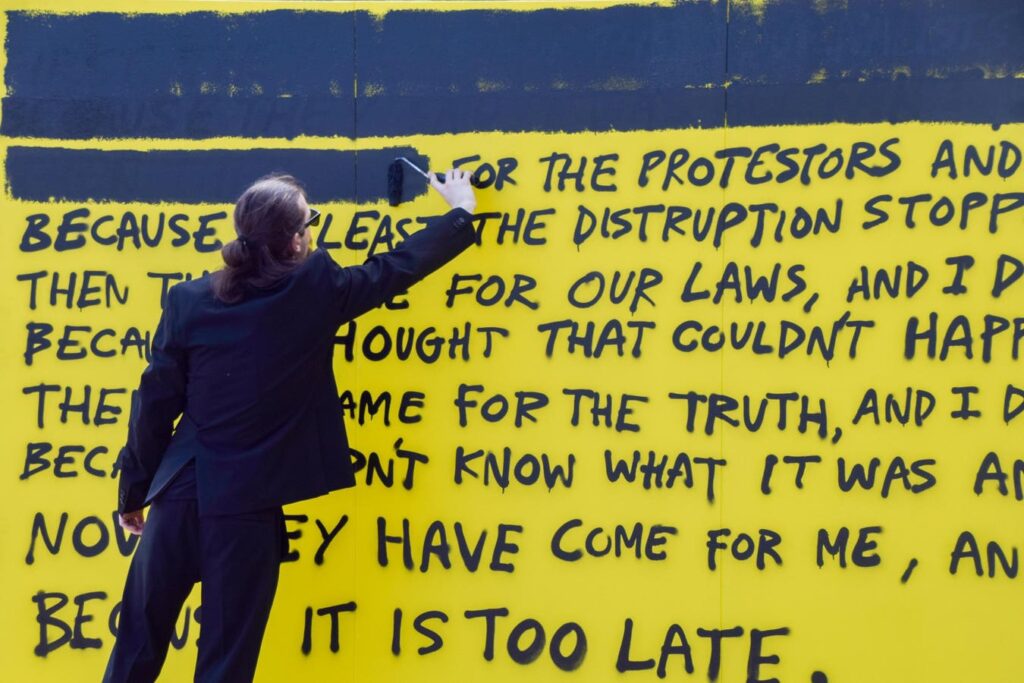An artist paints over a statement adapted from Martin Niemoller’s famous quote as part of an … More
SOPA Images/LightRocket via Getty ImagesPress freedom continues to be under threat globally, with journalists being killed or injured, others being censored, and media outlets being closed down, among others. According to the United Nations, since January 2025, at least 20 people who work in the media have been killed. Impunity for crimes against journalists remains widespread, with more than 80% of killings going unpunished. However, it does not stop there. Increasingly, the media are being used to spread misinformation and disinformation. In recent years, these challenges have been exacerbated by the use of technology, social media, and artificial intelligence (AI).
As indicated by the United Nations, the rapid growth and use of AI is changing journalism, the media, and press freedom, with AI having a profound effect on information gathering, processing, and dissemination. This comes with opportunities but also serious challenges.
AI can help support freedom of expression. It can make information easier to access, enable people to communicate across the world, and change information flows. However, AI also brings new risks. As warned by the UN, “[AI]
can be used to spread false or misleading information, increase online hate speech, and support new types of censorship. Some actors use AI for mass surveillance of journalists and citizens, creating a chilling effect on freedom of expression. Big tech platforms use AI to filter and control what content is seen, making them powerful gatekeepers of information. There are growing worries that AI may make global media too similar, reduce different viewpoints, and push out smaller media outlets.”
Volker Türk, United Nations High Commissioner for Human Rights, added that: “AI-based algorithms often dictate what we see, shaping our opinions and perceptions of reality. Politicians use AI to weaponize disinformation and advance their own agendas. States are also using AI tools to monitor journalists and their sources online, violating their right to privacy. This has a chilling effect on media workers everywhere. And women journalists are disproportionately targeted.”
Within these challenges, women journalists are said to be at particular risk, with technology-facilitated gender-based violence (TFGBV). As warned by the United Nations Educational, Scientific and Cultural Organization (UNESCO): “AI amplifies existing risks for women journalists in the digital landscape. (…) AI systems can generate deepfakes, doctored images, and mis/disinformation campaigns aimed at discrediting or intimidating women journalists. These AI-driven attacks jeopardize their safety but also have a chilling effect on their work, potentially limiting public access to information.”
Last, but not least, Mr. Türk further warned against the concentration of power in the area of AI, with a small group of corporations and individuals having almost total control over AI technology and influence on the global media landscape.
As such, it is crucial to examine how to make the most of AI to support the work of journalists and the media, but also address the challenges it poses.
On May 3, the international community marked World Press Freedom Day, a day designated by the United Nations to galvanize action to ensure and protect press freedom globally. This annual commemoration gives the opportunity to assess the state of press freedom throughout the world, defend the media from attacks on their independence, and pay tribute to journalists who have lost their lives in the line of duty, among others. This year, the World Press Freedom Day focused on the profound influence of AI on journalism and media. Mr. Türk said World Press Freedom Day is an opportunity for everyone to urgently commit to changing course now, starting with States. He called upon States to ensure that journalists are safe from attacks, hate campaigns and surveillance, as well as physical and legal harassment. He stressed that it was key to provide for more transparency in how data is used, how content is curated, and how algorithms are designed. Mr. Türk announced that his Office and UNESCO are offering guidance to help tech companies assess the risks their tools pose to journalists and civil society.
The ever-present challenges and threats posed to journalists and the media require comprehensive responses – to protect free and independent media and its key role in ensuring that democracies flourish.
Read the full article here


